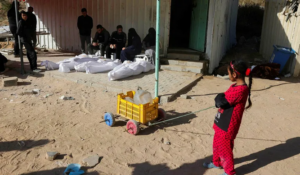The situation in Gaza is no longer a war, but an unrestrained assault on civilians

A girl looks at the bodies of family members killed in a strike on 17 April 2025 in Beit Lahia, northern Gaza
Jack Khoury writes in Haaretz on 18 April 2025:
Even those who don’t believe most of the people killed in Gaza are innocent cannot deny the horrific pictures of the humanitarian disaster there. The use of the word “war” for what is going on in Gaza is misleading and distorted. What’s happening in Gaza is not war. It’s an unbridled Israeli assault on people who are mostly uninvolved in any activity against it.
Israel’s “target bank” has long run dry. No administration buildings or “terror infrastructure” remain, and there’s no way to tell if all Hamas’ tunnels have been destroyed. Israel’s current terror targets are the militants who were seen in the video clips of the hostage releases. But there’s no way to know if they’re Hamas operatives or just actors and extras. In any case, following each of them could take months or years. If that’s the parameter for the “total victory” the prime minister aspires to, there’s a long way to go.
Israel is attacking from the air, ground and sea densely populated civilian sites in the Gaza Strip – encampments for refugees and displaced people, shaky buildings that still serve as shelters, like hospitals and UNWRA schools. The IDF spokesperson may speak of a “safe zone,” but in Gaza, nobody’s heard of that term.
Israel says there’s terrorism in those places too, that Hamas uses civilians as human shields, that Hamas activists are hiding in the population. This was claimed again this week after the attack on an Al Ahali Hospital building in Gaza City.
In reality, the only figures available show that most of the people who were killed and wounded in the last round of attacks were civilians, mostly women and children. Even if one doubts these figures’ source – the Hamas-run Gaza health ministry – the pictures don’t lie.
According to the ministry’s figures, since the end of the cease-fire on March 18, 1,691 people have been killed in Gaza. 595 of them are children, 308 women and 105 elderly people. Even assuming the rest of those killed are militants and terrorists, it’s likely that most of those killed are not involved in terror.
But apart from these killed people, we should remember: the humanitarian catastrophe taking place in Gaza now is placing two million Gazans on the brink of death by starvation and from diseases.
For more than a month, the Gaza Strip has been completely closed. Only those who have asked to leave are permitted to do so, and Israel boasts of it. Every medical and humanitarian system has collapsed, along with education and social systems. Israel’s excuse for this is that pressure on the population will yield results in the negotiations to release the hostages. Hamas claims that releasing the hostages in one round is possible if Israel agrees to end the war. But Netanyahu is demanding to disarm Hamas and to make it renounce every emblem of control and government.
Such a demand won’t solve the differences. Israel will continue to believe in military pressure, and Hamas will keep waving the only card it has left – the hostages’ lives.
Hamas is still not talking in terms of sacrifice and “Sumud,” the Palestinian principle of sticking to the land. It dismisses the arguments that it uses civilians to protect militants, but employs evasive rhetoric. As far as Hamas is concerned, all its operatives are Gazan civilians, and the moment a militant removes his uniform, he’s a civilian. That’s Hamas’ way, that’s the reality on the ground, and there’s no indication it will change. Meanwhile, the civilians who really are uninvolved are caught between two possibilities – to die or to agree to be driven away.
The hopes that the Gazan residents once pinned on all kinds of abstract entities – the international community, the international law, the international court, the Arab and Islamic world – turned out to be false. Israel objects to this comparison, but the civilians in Gaza have also been abducted and turned into hostages. In Israel, some people are still fighting for the hostages. In Gaza, they’re alone.
This article is reproduced in its entirety
